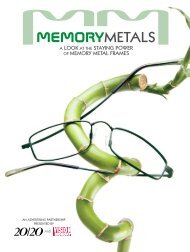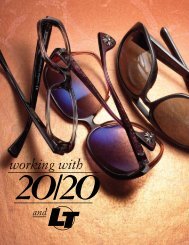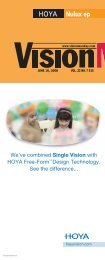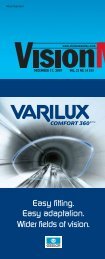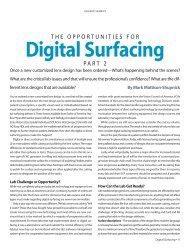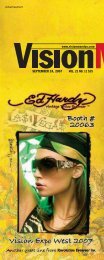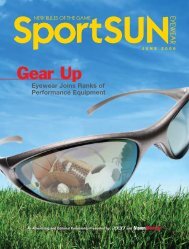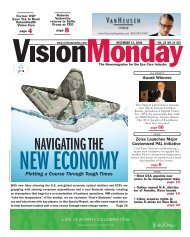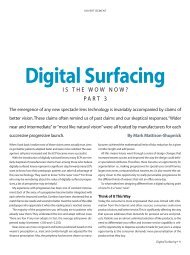The Opportunities For Digital Surfacing - Part 1
The Opportunities For Digital Surfacing - Part 1
The Opportunities For Digital Surfacing - Part 1
Create successful ePaper yourself
Turn your PDF publications into a flip-book with our unique Google optimized e-Paper software.
ADVERTISEMENT<br />
<strong>Digital</strong> surfacing allows the direct surfacing of molds and/or<br />
lenses.No translation per se is required.Of course,the cut surface is<br />
tested to be sure that it is the intended design. In addition, there<br />
is control of the cutting axes other than a base and cross curve so<br />
surfaces that can be described in multiple axes can be cut directly<br />
and cast or molded to produce SF progressives. Finally, lenses can<br />
also be digitally surfaced directly to produce progressive or other<br />
sophisticated surfaces.<br />
Dr. Mike Morris of Carl Zeiss Vision believes that progressives<br />
in the future will be divided into two types: fixed designs and<br />
customized designs.<br />
Fixed designs have preset characteristics such as size of<br />
viewing zones and corridor length that are consistent for all<br />
patients, and only the prescription powers are varied. While<br />
these can be delivered via digital surfacing to achieve the<br />
greatest possible clarity of vision, they cannot be considered<br />
designed for individual needs.<br />
Customized designs are created at the time of production<br />
based on specific wearer needs and the position of wear of the<br />
lenses. This means that several variables will be required to<br />
produce a customized progressive lens.<strong>The</strong>se variables include<br />
the way in which lens power is distributed between the front<br />
and back surface, the specific fitting characteristics of the<br />
frame and how the patient will use the spectacles.<br />
This is something we all need to prepare for, because the<br />
prescription may be the same, but the lens that delivers the<br />
prescription will be different in entirely new ways.<br />
Customization will alter the lens design with patient information<br />
other than the prescription, PD and fitting height. It will deliver<br />
some or all of the following: powers compensated for lens tilt, vertex<br />
distance and wrap angle.<strong>The</strong> peripheral characteristics can be<br />
optimized for position of wear, corridor length and viewing zone<br />
size. Front surface progressives can be further optimized by specially<br />
cutting the back surface to reduce unwanted errors in the<br />
periphery away from the corridor. Peripheral design will be modified<br />
based on the frame chosen and fitting height needed. Reading<br />
distance or multiple corridor lengths can be specified. Others<br />
will add design changes for daily tasks i.e.,the estimated percent of<br />
time spent driving,working at a computer,walking,sitting,etc.Finally,others<br />
will incorporate measurements of how the eyes and head<br />
move when reading or using other areas in the lens.<br />
Which prescriptions will benefit from which of these customizations?<br />
How much will they cost? How long will they take to get?<br />
What tools will the ECP need to actually order lenses with these<br />
attributes? First,if the lab will deliver this,what are they asking? Let’s<br />
take a first look at some lab questions.<br />
Lenses Cut Using Single Point Diamond Turning<br />
How does single point<br />
diamond turning deliver<br />
the ability to improve<br />
and customize progressive<br />
lens surfaces? It is the<br />
spinning of a mold or<br />
lens against a single point<br />
cutter while moving the<br />
lens closer and farther<br />
from the cutter. This<br />
results in a series of<br />
joined surface heights<br />
that deliver a specific progressive<br />
design.<br />
<strong>For</strong> Varilux Physio, the<br />
design is cut and polished<br />
on a mold’s back surface.Lenses are then cast and the accuracy<br />
of production of the design is verified. Any changes that are<br />
necessary are made to the software that controls the cutting operation.<br />
Testing determines how many software changes are<br />
required until the design is right.Wearer testing also confirms the<br />
design required.<br />
<strong>For</strong> a lens like Zeiss Gradal Individual, the design is cut directly<br />
onto the back surface of a single vision lens blank. Regardless of<br />
front or back, designs are verified to know that they deliver the<br />
vision clarity intended.<br />
More about design differences in the next issue.<br />
Labs Are Considering…<br />
If lenses can now be directly surfaced with digital control, then<br />
where can I get them?<br />
Currently, a variety of customized designs, each with different<br />
attributes,are available from Essilor of America (Varilux Physio360,<br />
Varilux Ipseo, Definity, Definity short and Accolade Freedom) and<br />
Carl Zeiss Vision (SOLAOne HD, Zeiss Gradal Individual). HOYA,<br />
Shamir,Signet Armorlite and SEIKO each have a design with some<br />
customization available.<br />
Optical lab owners are asking themselves whether now is the right<br />
2• <strong>Digital</strong> <strong>Surfacing</strong>




